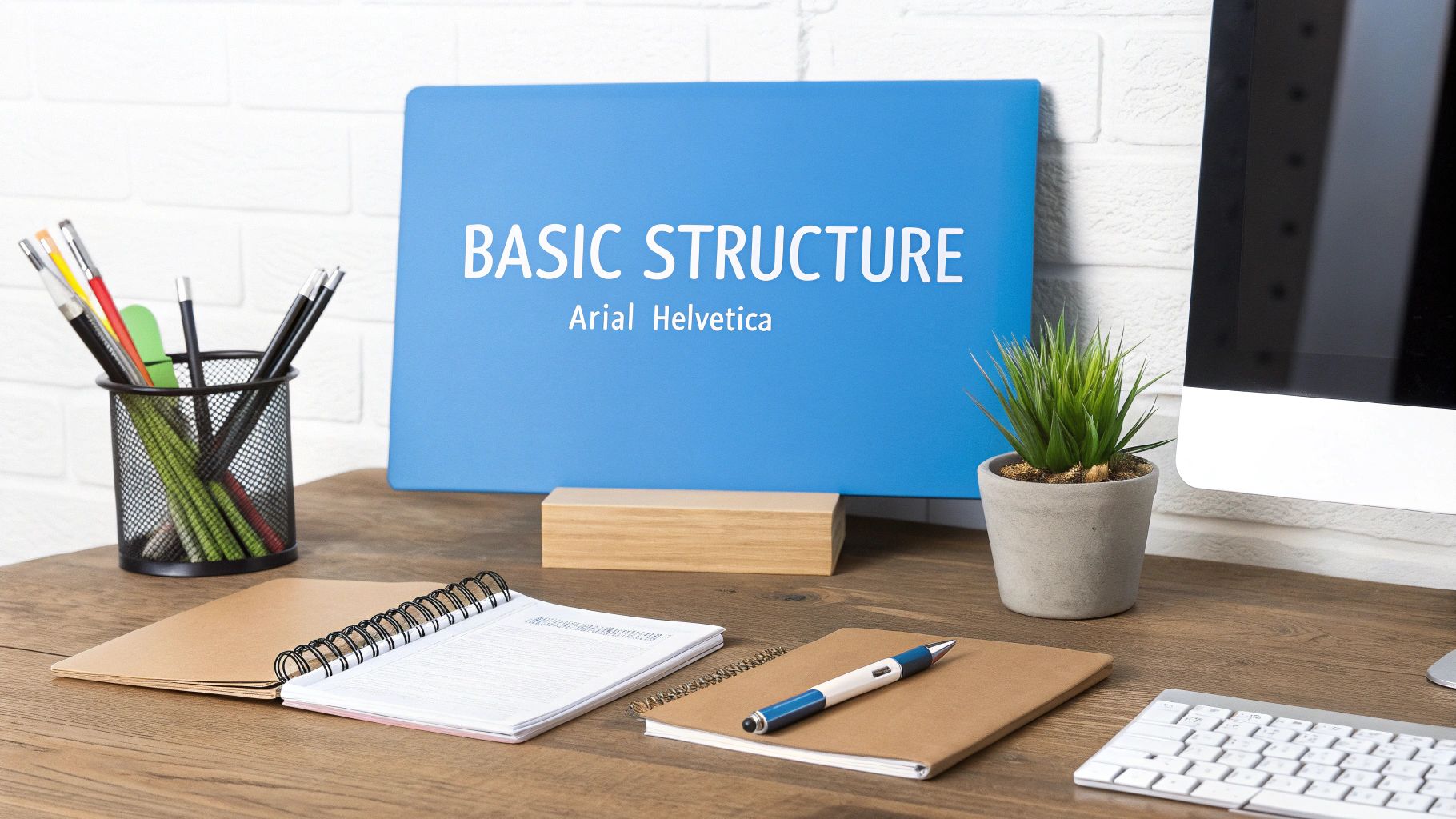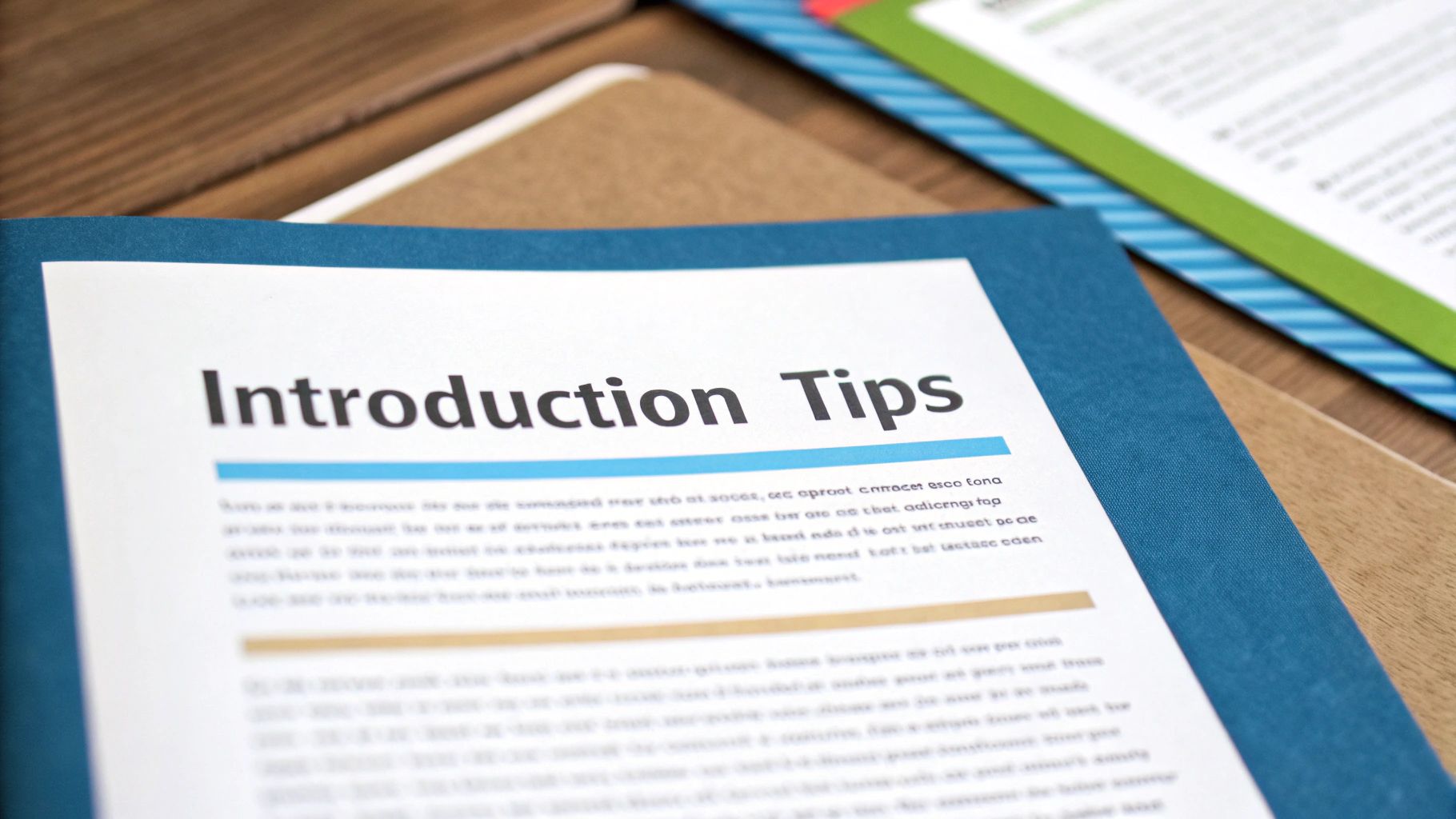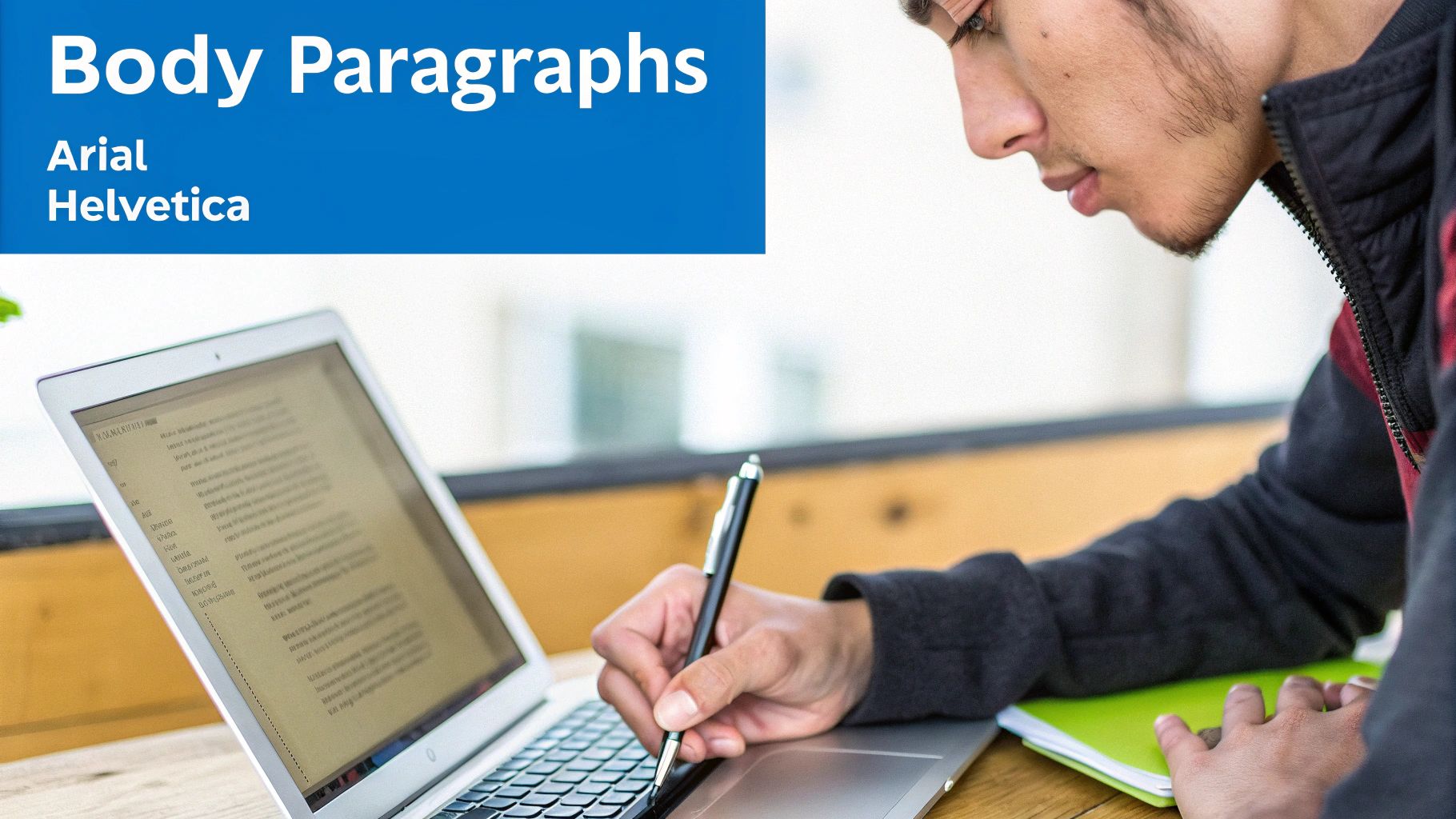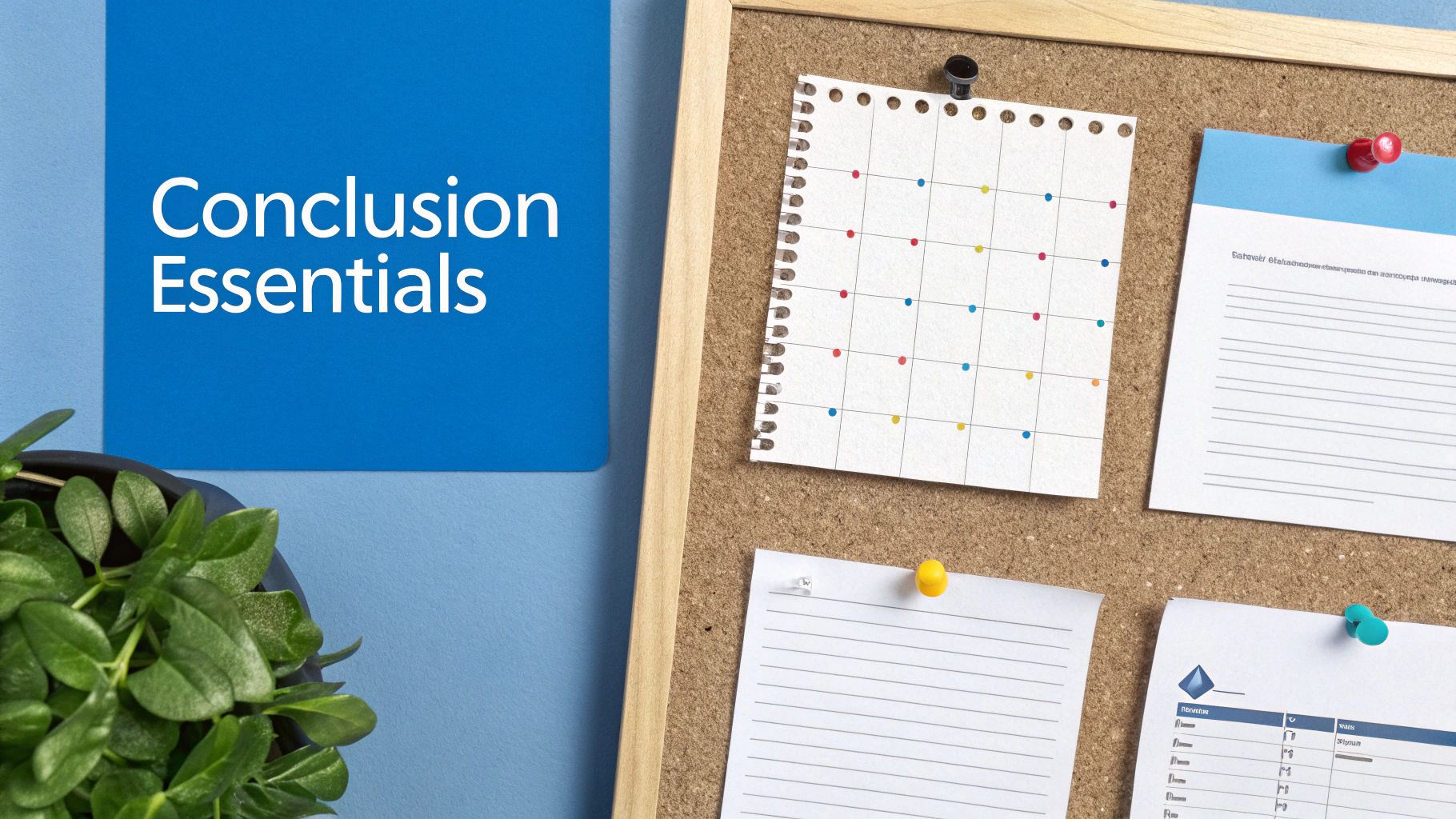Breaking Down the Perfect Essay Structure

Every successful academic essay relies on clear organization and structure. Just as architects need blueprints to construct buildings, writers need a logical framework to present their ideas effectively. Understanding the basic building blocks of essay structure and how they fit together allows you to communicate your arguments with clarity and impact.
The Core Components of an Essay Structure Template
Essays are built on three main sections that work together seamlessly: the introduction, body paragraphs, and conclusion. Think of these parts working like a sandwich – the introduction and conclusion are the bread slices that hold together the meaty content in between.
-
Introduction: This opening section grabs readers' attention while setting up your main argument. A strong introduction provides context about your topic and presents your thesis statement – the central claim you'll prove throughout the essay. For instance, if you're writing about climate change solutions, your introduction would outline the problem and state your position on the most effective approaches.
-
Body Paragraphs: These paragraphs form the heart of your essay where you present your key points and evidence. Each paragraph should focus on a single main idea that supports your thesis. If you're writing about renewable energy benefits, one paragraph might discuss reduced emissions while another covers economic advantages. Make sure to back up claims with specific examples and evidence.
-
Conclusion: Rather than simply restating your introduction, use the conclusion to synthesize your main points and leave readers with fresh insights. Consider broader implications or suggest areas for future research. The goal is to reinforce your argument while giving readers something meaningful to reflect on.
Utilizing an Essay Structure Template Effectively
Following a template doesn't mean writing formulaic essays – instead, it provides a foundation that you can adapt to different assignments and topics. Like architectural plans that can create diverse buildings, essay templates offer flexibility while maintaining structural integrity.
The way you use the template depends on factors like essay length and type. A brief 500-word essay needs a more condensed approach than a 10-page research paper. Different essay styles also require structural adjustments – analytical essays examine topics systematically, while argumentative essays build persuasive cases. You might find this resource helpful: How to master essay generation.
When you understand how to work with essay structure effectively, you can organize complex ideas clearly and craft compelling academic writing. This essential skill helps you excel across different courses and assignment types.
Crafting Introductions That Command Attention

First impressions matter, especially in academic writing. The introduction sets the tone for your entire essay and determines whether readers will stay engaged or lose interest. A well-crafted opening does more than just present your topic – it draws readers in and clearly lays out your argument while establishing your credibility as a writer. When you master introduction writing using proven essay templates, you'll see a dramatic improvement in how effectively your essays communicate your ideas.
The Purpose of a Strong Introduction
Your introduction needs to accomplish several key goals. First, it provides essential background context to help readers understand why your topic matters. For instance, an essay about social media's impact on politics might open by highlighting how platforms like Facebook and Twitter have fundamentally changed how people consume and share political information. This context shows readers why they should care about your analysis.
The introduction is also where you present your thesis – the core argument that your essay will develop and support. Your thesis should be specific enough to be provable but broad enough to be explored in depth. Finally, a strong introduction previews your main supporting points, giving readers a clear roadmap of how your argument will unfold. These elements work together to create a focused, purposeful opening.
Essential Elements of an Effective Introduction
Several key components work together to create an engaging introduction. The "hook" comes first – an opening line designed to grab attention through an intriguing question, surprising fact, or relevant story. This initial engagement encourages readers to keep going.
After the hook, you need to build context by providing background information that helps readers understand your topic. This might involve defining important terms, summarizing relevant history, or explaining key concepts. The context creates a bridge between what readers already know and the specific focus of your essay.
At the heart of your introduction is the thesis statement that clearly articulates your central argument. End by previewing your main supporting points to show how you'll develop that argument. Think of this as a concise outline of the key ideas you'll explore in detail. When these elements flow naturally together, they create an introduction that both informs and engages.
Applying Essay Structure Templates to Introductions
Using proven essay templates helps ensure you include all necessary elements while allowing flexibility to adapt to different types of writing. Here's how templates work for common essay types:
For argumentative essays, open with a clear position statement followed by a brief overview of opposing views. State your thesis and preview the evidence you'll use to support your stance. This structured approach sets up a persuasive, well-organized argument.
When writing analytical essays, begin by introducing what you'll analyze. Define your specific focus and purpose, outlining which aspects you'll examine. Your thesis should present your central interpretation or conclusion. The template keeps you focused on careful analysis.
For research papers, start by presenting your research question or problem. Provide background on existing studies, noting any gaps or debates in the field. Your thesis should clearly state your findings and explain how your research contributes new insights.
Following these templates while crafting introductions helps you create openings that engage readers and establish a clear direction for your essay. The key is maintaining focus while allowing your unique perspective and writing style to shine through.
Building Dynamic Body Paragraphs

While strong introductions and conclusions frame your essay, the body paragraphs are where your key arguments take shape. These paragraphs serve as the foundation of your essay, presenting evidence and analysis that convince your reader. Let's explore how to craft compelling body paragraphs that both support your main points and keep readers engaged through effective structure and flow.
Structuring Your Body Paragraphs: The P.E.E.L. Method
The P.E.E.L. method offers a clear framework for organizing body paragraphs logically and persuasively. This approach – Point, Evidence, Explanation, and Link – helps you present information in a way that reads naturally while building a strong case. Think of each paragraph as a mini-argument that adds another layer to your overall thesis.
-
Point: Start with a focused topic sentence that connects directly to your thesis. This sentence guides readers through your reasoning. For example, if you're writing about renewable energy benefits, your topic sentence might highlight how solar power reduces carbon emissions.
-
Evidence: Back up your point with specific facts, statistics, examples, or expert quotes from reliable sources. Your research shines here. You might include recent data showing the significant drop in solar panel installation costs to demonstrate economic viability.
-
Explanation: This is where you interpret the evidence and show why it matters. Connect the dots between your evidence and main point, helping readers understand the significance. For instance, explain how lower solar panel costs enable more households to switch to clean energy, creating broader environmental impact.
-
Link: End by tying the paragraph back to your thesis or smoothly transitioning to your next point. This creates a clear connection between individual arguments and your overall message. You might conclude by noting how the environmental and cost benefits of solar power support its role in sustainable energy solutions.
Maintaining Flow and Engagement
Beyond P.E.E.L., several techniques help create smooth, engaging paragraphs. Use transition words and phrases naturally – "However," "As a result," or "Similarly" – to connect ideas clearly. Mix up your sentence structure and length to maintain reader interest. Each paragraph should flow naturally into the next, like stepping stones guiding readers through your reasoning.
While the P.E.E.L. method provides solid structure, the key to truly effective body paragraphs lies in how well you blend evidence and analysis. Focus on creating clear connections between ideas while keeping your reader's attention through varied sentence patterns and natural transitions. When done well, your paragraphs work together to build a persuasive case for your thesis.
Mastering Source Integration and Evidence

Strong body paragraphs rely on skillfully incorporating evidence from sources. This means smoothly blending external research and quotes into your writing in ways that support your ideas while maintaining your distinctive voice. Let's explore practical techniques for using sources effectively in your essays.
Choosing the Right Evidence
Your choice of evidence should match your essay's purpose and audience. For analysis essays, look for sources that offer detailed interpretations and critical perspectives. When making arguments, mix different types of support – statistics, expert opinions, and real examples often work well together. For instance, if you're writing about social media's effect on politics, you might combine academic research on media influence with voter engagement data and specific examples from recent campaigns.
Integrating Quotes Effectively
Well-chosen quotes add authority to your writing, but use them carefully. Skip long block quotes that break your essay's flow. Instead, pick brief, focused quotes that directly support your points. Always introduce quotes with context and explain why they matter. For example, when using a quote about social media's persuasive power, clarify how it connects to the specific campaign strategy you're discussing. This helps readers see the quote's relevance to your larger argument.
The Power of Paraphrasing
Putting source ideas into your own words helps maintain consistent style and flow. Good paraphrasing shows you understand the material since you must process and reframe the information. This approach works especially well with complex theories or dense research – you can present key ideas more clearly while staying true to the original meaning. You might find this citation generator helpful for properly crediting sources.
Managing Contrasting Viewpoints
Including opposing views strengthens your arguments by showing you've considered multiple perspectives. Present counterarguments fairly, then respond with evidence-based rebuttals. This balanced approach builds credibility with readers. For example, when discussing renewable energy benefits, acknowledge concerns about transition costs. Then present research showing long-term cost savings to address those worries effectively.
Strategic Source Placement
Where you position evidence matters. Place sources right after key claims to provide immediate support. Use source material to create smooth transitions between paragraphs and show connections between ideas. For instance, end a paragraph about environmental benefits with emissions data, then transition to economic advantages using relevant research. This careful placement creates a well-organized argument that flows naturally from point to point. Strategic source use helps build a clear, persuasive case while maintaining strong paragraph structure throughout your essay.
Creating Conclusions That Leave a Lasting Impact
Well-structured essays need solid conclusions that tie everything together. After covering how to build strong introductions, body paragraphs, and incorporate sources effectively, let's examine how to create memorable conclusions. The final section of your essay provides a chance to connect key themes, explore broader implications, and make your ideas resonate.
Beyond the Basic Summary: The Purpose of a Powerful Conclusion
While restating main points has its place, a strong conclusion does much more. Think of it like the final notes of a musical piece – it should feel complete while leaving a lingering impression. Rather than just repeating your thesis, use the conclusion to offer fresh insights that demonstrate deeper understanding. For example, an essay about renewable energy could conclude by examining opportunities for international cooperation on sustainability, giving readers something meaningful to consider.
Strategies for Crafting a Compelling Conclusion
To build an effective conclusion, weave together key takeaways from your body paragraphs to reinforce your central argument. Consider the wider significance of your analysis – how does it add to existing knowledge? Does it challenge common assumptions or suggest new research directions? These questions add intellectual depth to your conclusion.
For instance, a paper analyzing social media's effects on political discourse might end by examining potential long-term impacts on democracy, encouraging readers to think critically about societal implications. You can also conclude with a thought-provoking question, call to action, or prediction that gives readers a new perspective on the topic.
Essay Structure Template for Conclusions: Adapting to Different Essay Types
Different essay types need different conclusion approaches. A comparative essay might finish by highlighting key similarities and differences between subjects and making a final assessment. An argumentative essay could powerfully restate the thesis while summarizing the strongest evidence supporting the author's position.
Whatever the essay type, maintain a consistent voice and style throughout. Sudden shifts in tone can disrupt the flow and weaken your conclusion's impact. Check out our guide on How to master grammar and style for tips on staying consistent. This helps create a polished final product.
Avoiding Common Conclusion Pitfalls
Several mistakes can reduce a conclusion's effectiveness. Simply restating the introduction without new insights is one common error. Another is introducing completely new arguments that belong in the body paragraphs. Be careful to avoid vague generalizations that lack substance or clear connections to your analysis. By sidestepping these pitfalls, you can create conclusions that effectively synthesize your work, strengthen key arguments, and make a real impression on readers. When paired with solid essay structure, well-crafted conclusions become powerful tools for academic success.
Adapting Templates for Different Academic Challenges
Understanding how to modify basic essay templates for different types of assignments is a key academic writing skill. Just as craftspeople select specific tools for each project, writers need to adapt core essay structures to match the requirements of various assignments – from high-pressure timed exams to comprehensive research papers.
Tailoring the Essay Structure Template for Timed Exams
Time constraints make timed exams particularly challenging. To succeed, you'll need a more concise version of the standard essay template. For instance, you might condense a five-paragraph essay into four paragraphs by combining background information and thesis into one focused introduction. This allows you to address the prompt efficiently while maintaining clear organization. Having pre-prepared templates for common essay types, like comparison or argumentation, can also save precious minutes during the exam. Regular practice with these modified templates builds writing fluency, similar to how musicians practice scales to perform smoothly under pressure.
Adjusting the Template for Research Papers
Research papers demand a broader approach than shorter essays. While keeping the basic introduction-body-conclusion framework, each section needs significant expansion. The introduction should establish a clear research question and review existing literature thoroughly. Body paragraphs require careful source integration and detailed analysis. For longer papers around 10 pages, creating a detailed outline with multiple subheadings helps maintain organization throughout. Think of it like architectural planning – a comprehensive blueprint ensures the entire structure remains stable and cohesive.
Addressing Specific Prompt Requirements
Close analysis of assignment prompts reveals which aspects need special emphasis. History essays might require chronological analysis, leading you to organize body paragraphs by time period. Philosophy assignments often focus on examining counterarguments, so you may need dedicated sections for opposing viewpoints or modified conclusions that reconsider initial arguments. Like a skilled tailor adjusts patterns to fit exact measurements, your essay structure should align precisely with prompt specifications.
Maintaining Quality Under Pressure
Strong writing fundamentals matter regardless of the assignment type. Even with tight deadlines or complex research requirements, focus on clear topic sentences, solid evidence, and smooth transitions between ideas. During timed exams, make each sentence purposeful and avoid unnecessary complexity. For research papers, carefully explain how each source supports your argument rather than simply inserting quotes. By consistently applying these principles, your writing stays effective even under challenging conditions – similar to how professional chefs maintain high standards during busy service times.
Ready to streamline your essay writing process and tackle any academic challenge with confidence? SmartStudi offers a suite of AI-powered tools designed to help you excel, from AI and plagiarism detectors to essay generators and citation generators. Check out SmartStudi today and unlock your full academic potential: https://smartstudi.com
